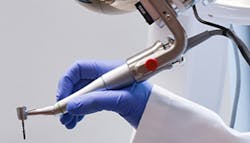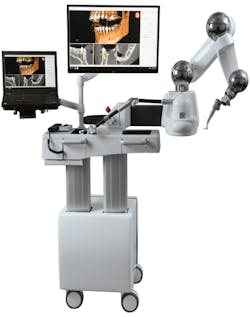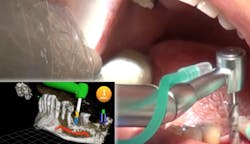Innovations in dentistry: Navigational surgery, robotics, and nanotechnology
Robotics in navigational surgery
Advancements in technology and computer science have led to an increase in the use of robotics in navigational surgery for multiple medical specialties. From the development of the da Vinci surgical system in the early 2000s to more advanced artificial intelligence (AI) techniques in use today, similar revolutionary technologies are now being introduced into the dental field that can assist practitioners with a variety of procedures. The use of robotics in dentistry provides advantages over freehand techniques for placing instrumentation.1 These systems, along with navigational guidance, offer increased accuracy and precision in dental treatment as well as streamlined work processes and better workflows, resulting in higher quality of care.2 Robotics-assisted dentistry has evolved from traditional navigational surgery to more complex systems that will prove to be essential in the maintenance of oral health and repair of oral lesions using nanomaterials, nanorobots, and engineering of novel diagnostic and therapeutic modalities.3 While these therapeutic interventions alter our contemporary views and understanding, robotics systems are already being used in dental procedures and are assisting practitioners with implant treatment.3 Undoubtedly, other areas of dentistry that could benefit from robotic systems and AI applications include endodontics, general procedures in restorative dentistry, orthodontics, and periodontics.
During traditional guided implant surgery, a surgical guide is placed to help the clinician navigate drilling during. However, surgical guides may be ill-fitted or seated improperly, causing incorrect angulation while performing surgery.7 In addition, the surgical guide requires a longer drill, which means the patient has to open his or her mouth very widely to allow the clinician more room to work, a problem for some patients.7 Furthermore, guided implant surgery is considered to be static, and creates limitations when the clinician needs the ability to change direction during the procedure.7 Yomi technology allows for these sudden changes during implant surgery with ease.1
Yomi provides an alternative approach in surgical implant treatment, as this technology supplies the clinician with preoperative, intraoperative, and postoperative plans and clinical decision support during implantMicrorobots
Navigational surgery and robotics allow for consistency, superior workflow efficiency, and increased patient safety; all of which lead to higherWhile navigational surgery, robotics, and microrobots are making their way into dental treatment, other opportunities for robotics within the dental field exist through nanotechnology. Nanotechnology refers to the designing, building, and engineering of nanobots.10 Nanobots are microscopic robotic machines that are close to a nanometer in size, may consist of thousands of mechanical pieces, and can be used for the purpose of interacting with or manipulating cells in the human body.9 Currently under development, nanobots are expected to change medical diagnosis and treatment, as well as methods of drug delivery.10 Furthermore, nanotechnology may play a vital role in surgery, the treatment of cerebral aneurysms, gene therapy, cancer detection and treatment, and general diagnosis and treatment within the dental space.10
Nanodentistry
Application of nanotechnology in dentistry, also known as nanodentistry, allows for treatment possibilities in restorative dentistry, orthodontics, and periodontics.11 Within restorative dentistry, nanorobotics can be used in cavity preparation, restoration, and even dentition renaturalization.9,11 Due to their size, nanobots work at the atomic, cellular, and molecular level to perform major tasks and can help dentists in managing complicated cases at the microscopic level with ease and precision.12 Furthermore, dental materials have the potential for improvement, as nanosolutions can ensure homogeneity in bonding agents and nanofillers can improve hydrophilic properties for impressions.11 Nanotechnology can also aid in bone replacement and antibiotic delivery via nanoencapsulation while offering continuous oral health maintenance using dentifrobots to destroy pathogenic bacteria found in plaque biofilms.11,13 Additionally, nanodentistry can offer alternative techniques to induce anesthesia and manipulate tissue to aid in managing complicated restorative and periodontal treatments.12
Conclusion
Robotics systems continue to support doctors in the medical field with assistance in the cardiac space, orthopedics, and within neurosurgery.7 Robotics, microbots, and nanotechnology have the potential to support dentists and positively impact the field of dentistry. However, compared to their counterparts in the medical field, dentists have been slow to adopt this new technology. As a case in point, dentistry appears to be more than a decade behind in adopting or integrating new technologies on a widespread basis.14 It is important to note that as each of these AI and robotics developments advance in health care, it will be better for experts to explain the benefits of these advances, rather than the technology, to increase the adoption curve and lessen any fears about the use of AI and robots in the medical space.15 As dental professionals, it is important to embrace new technologies and be educated on the associated risks and benefits when used in dentistry. The realization that new and emerging technological innovations may provide alternative treatments to patients while enhancing workflow, increasing production, and improving the quality of care is on the horizon. Considering that the overall goal in dental care is to provide optimal patient treatment, it is worth reviewing these applications and their potential to increase the quality of dental care. Robotics and AI techniques can provide dental practitioners with valuable information in real time, allowing for more thorough examinations, accurate diagnoses, and clinical decision support throughout the duration of dental procedures. The a quest for advancements in dentistry is never ending, and the use of robotics for dental treatment could soon become standard practice for all dentists.
References
- Kochanski RB, Lombardi JM, Laratta JL, Lehman RA, O'Toole JE. Image-Guided Navigation and Robotics in Spine Surgery. Neurosurgery. 2019;84(6):1179-1189. doi:10.1093/neuros/nyy630
- Neocis. The First Surgical Robot Designed for Dental Implant Surgery, Yomi®, Surpasses 1000 Implants. Globenewswire. Published January 7, 2020. Accessed August 29, 2020. https://www.globenewswire.com/news-release/2020/01/07/1967413/0/en/The-First-Surgical-Robot-Designed-for-Dental-Implant-Surgery-Yomi-Surpasses-1000-Implants.html
- Wilson DJ. What is Nanodentistry? News Medical Life Sciences. Updated October 18, 2018. Accessed September 13, 2020. https://www.news-medical.net/health/What-is-Nanodentistry.aspx
- Smith Y. Dental Implant Risks. News Medical Life Sciences. Updated February 26, 2019. Accessed August 18, 2020. https://www.news-medical.net/health/Dental-Implant-Risks.aspx
- Higuera V. What to Know About Dental Implant Complications and Failure. Healthline. Published September 4, 2018. Accessed August 20, 2020. https://www.healthline.com/health/dental-implant-problems
- Levin L. Dealing with dental implant failures. J Appl Oral Sci. 2008;16(3):171-175. doi:10.1590/s1678-77572008000300002
- Coutre L. Drilling into the future of robot-assisted dentistry. Modern Healthcare. Published September 25, 2019. Accessed August 5, 2020. https://www.modernhealthcare.com/technology/drilling-future-robot-assisted-dentistry
- Mittal S, Kumar T, Mittal S, Sharma J. Endodontics Generation Next- Microrobotics of The Article-Review. Dasmesh Institute of Research and Dental Sciences. Accessed September 3, 2020. https://pdfs.semanticscholar.org/d781/2a489f151ddb01053000ce974370d422ad6a.pdf
- Rawtiya M, Sethi P, Verma K, Loomba K. Application of Robotics in Dentistry. Indian Journal of Dental Advancements, 2014;6(4):1696. https://www.researchgate.net/publication/297409830_Application_of_Robotics_in_Dentistry_Quick_Response_Code
- Nanorobots and Its Medical Applications – Advanced Materials 2019. Materials Science. Published October 11, 2018. Accessed September 13, 2020. https://advancedmaterials2018.wordpress.com/2018/10/11/nanorobots-and-its-medical-applications-advanced-materials-2019/
- Shetty NJ, Swati P, David K. Nanorobots: Future in dentistry. Saudi Dent J. 2013;25(2):49-52. doi:10.1016/j.sdentj.2012.12.002
- Chawla K. Nanorobots: The wonder machines in dentistry. 2017. doi:10.13140/RG.2.2.12229.14564
- Bordoloi P, Shahira S, Ramesh A, Thomas, B. Nanorobotic wonders: A revolutionary era in periodontics. Indian Journal of Multidisciplinary Dentistry, 2018; 8(2): 101-105. http://www.ijmdent.com/article.asp?issn=2229-6360;year=2018;volume=8;issue=2;spage=101;epage=105;aulast=Bordoloi
- Child P. Digital dentistry: Is this the future of dentistry? Dental Economics. Published October 1, 2011. Accessed September 13, 2020. https://www.dentaleconomics.com/science-tech/article/16394539/digital-dentistry-is-this-the-future-of-dentistry
- Marius E. 6 Ways AI and Robotics Are Improving Healthcare. Robotics Business Review. Published May 29, 2019. Accessed September 11, 2020. https://www.roboticsbusinessreview.com/health-medical/6-ways-ai-and-robotics-are-improving-healthcare/
Editor’s note: This article first appeared in Through the Loupes newsletter, a publication of the Endeavor Business Media Dental Group. Read more articles at this link and subscribe here.
About the Author
Shannon Sommers, MSHI, BTDH, RDH
Shannon Sommers, MSHI, BTDH, RDH, has a bachelor's of technology in dental hygiene from the State University of New York at Canton and a master of science in health informatics from the Medical University of South Carolina. She has over 20 years’ experience in dentistry and has been a dental hygienist since 2006. She aims to use her dental background and informatics skills to influence population health by promoting and advancing the use of dental informatics.
Updated September 23, 2020
Alicia Webb, MSHI, BTDH, RDH
Alicia Webb, MSHI, BTDH, RDH, has been a clinician in dentistry since 2006 and has experience as an educator in dental hygiene. As one of the few registered dental hygienists to graduate with a master of science in health informatics, she wants to use her informatics knowledge coupled with her dental background to improve population health by developing and analyzing data-driven solutions to improve the delivery of quality dental care.
Updated September 23, 2020





